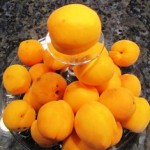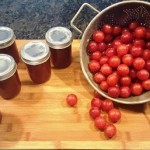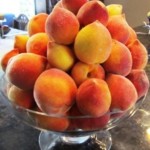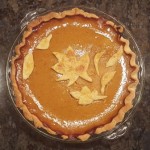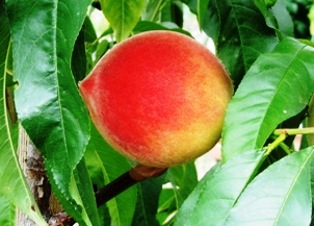Fruit Spreads Make Life a Little Sweeter
On the Henny Penny Farmette, we care for a small orchard of fruit trees. Each spring, summer, and fall, we harvest fruits to make sweet spreads. Whether spooned onto warm bread or waffles, scooped onto ice cream, or sandwiched between cookies, our homemade spreads offer a tasty reminder of the seasons of warmth.
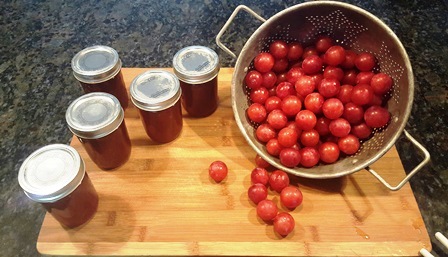
There are lots of different types of spreads, including chutneys, compotes, conserves, fruit butters, jams, jellies, and preserves. Each type has special characteristics. The following lists outline some of the differences between these delicious spreads.
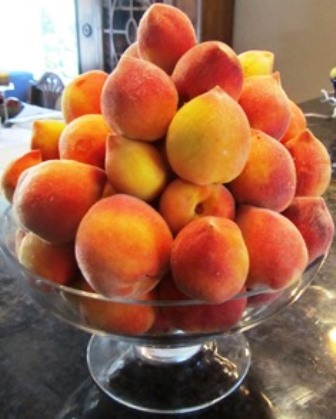
The Three C’s–Chutneys, Compotes, and Conserves
Chutneys are condiments that offer a variety of textures, from smooth to chunky, due to the type of fruit used as well as the blend of sugar, spices, and vinegar. The addition of chili peppers adds heat.
Compotes are often composed of fruit, either whole or in pieces, in a sugar-water syrup that includes spices.
Conserves are flavor- and texture-enhanced by adding to the jam such ingredients as dried fruit and nuts.
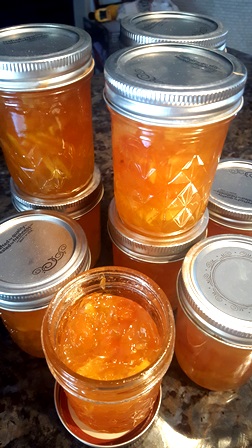
Preserves are spreads that include chunks of fruit cooked into the jam mixture. A marmalade is a type of preserve. We like marmalade made from citrus such as naval and blood oranges, lemons, and kumquats. You can make a lovely berry preserve by combining different types of berries with a sparkling juice, lemon zest, and sugar. Or, try cranberries and oranges for a tasty preserve for morning toast.
Fruit butters are spreads that have been cooked until all fruit has been incorporated in a buttery consistency. These blends of fruit and spice make them particularly sweet.
Jellies are made mainly from the juice of fruit cooked with sugar and pectin (to thicken). We make jelly from our late summer pomegranates, but your options are expansive when you consider all the types of fruits, flowers (yes flowers, like violet and lavender make wonderful jellies), and fruit juices that can be combined into a delicious jelly.
If you enjoy reading about gardening, preserving produce and fruits, and other country living topics, check out my Henny Penny Farmette series of cozy mysteries. The novels and my self-help, wellness, and spirituality books are available online and everywhere books are sold. See, https://www.amazon.com/Meera-Lester/e/B001JP835E%3Fref=dbs_a_mng_rwt_scns_share
Late to Ripen But Oh, So Yummy!
Following the historic long seasonal deluge of rain, our fruit trees are loaded with peaches, apricots, plums (the cherries are gone now). While there is plenty of stone fruit, it’s all ripening late this year.
Our Blenheim apricots were ready to pick, dry, and make into jam in late May of 2018. On this last day in June, I plucked an apricot that was ripe on the side facing the sun but the opposite side was green and hard.
The cherries, too, ripened late this year. We picked about 8 gallons of cherries from our two Bing and Stella trees. I dried some and we gave away a lot.
The Black Tartarian cherries didn’t produce as heavily this year as last. By the time we discovered the ripe cherries, the birds had already beaten us to the super-sweet fruit. I don’t mind sharing with the local wildlife, but would have loved a bowl of these for snacking.
The yellow and red plums are finally ripe now. Today, I’m making plum jam. Nothing beats hot toast with spreadable summer jams and marmalade for breakfast on a winter’s day. In a normal year, most of my jam-making of stone fruits would be finished by now.
The early Desert Gold peaches are gone now, a tasty memory, from a month ago. However, we still have summer peaches clinging to the tree. I check them daily. Fresh peach pie for the fourth of July is a favorite at my house.
While the fruits and berries seem to ripen more slowly this year, my vegetable garden is blowing my mind. I have several raised beds in a fenced-off area so wild animals won’t bother it. Most of the raised beds were used for composting (think, tons of chicken manure, yard clippings, and cardboard). Still, I added other organic amendments. Boy, is that soil paying off.
It’s a banner year for vegetables on the farmette. Most will be eaten fresh but the sugar pumpkins won’t ripen until autumn. Love them in pie.
_____________________________________________________________________________________
I’ve been told I’m living a “charmed life” on my Henny Penny Farmette. And so it is. But this chapter of my life didn’t happen by accident. I once lived in Silicon Valley and was part of life in the fast lane, which I enjoyed. But I grew up on a farm. I missed time in nature, eating foods that I knew were healthy and wholesome and pesticide-free, and the slower pace of life. I set an intention to manifest the life I have now. You can, too.
FIND ME ALSO at Meera-lester.com (don’t forget that hyphen…very important.)
If you enjoy reading about gardening, keeping chicken and bees, and other farm topics, pick up copies of my Henny Penny Farmette series of cozy mysteries. The books are chocked full of farm and craft trivia as well as delicious recipes and, of course, intriguing mysteries.
Busy Bees and Abundant Rain Spell Bumper Crops in the Orchard
Thanks to the drought-ending rain and the robust activity of our honeybees, my orchard has produced a phenomenal crop of cherries, apricots, and plums this year.
I picked some wild plums today. They’re unusually sweet so I will make them into jam this week. I think the apricots will be ready next week. Today, I’m getting ready for jam-making by taking down cases of canning jars from the storage shelf over the washer and dryer. I’ll need to get lemons, bags of sugar, pectin, and jar lids.
The vegetable garden is also benefiting from bee activity. The summer Italian striped squash and the crooked neck squash plants are producing squash faster than we can eat them. The tomato vines are loaded, and I expect the corn to be ready soon, too.
Nothing beats fresh summer jams to brighten a dreary winter morning. This summer, I hope to make enough to last through 2017 winter into next spring. This past winter, I ran out of apricot jam because it is the one most of our neighbors, family, and friends prefer. But thanks to the rain and the bee activity, running out of jam won’t be a problem for next year.
____________________________________________________
Like my honeybees, I’ve been busy this winter/spring, writing two nonfiction books for readers who embrace the path of yoga, healthy living, meditation, meaningful ritual, and mindfulness. To be released this year: My POCKET MEDITATIONS (July 2017) and MY DAILY RITUALS (Christmas 2017).
Check out MY POCKET MEDITATIONS, the newest forthcoming nonfiction title from Adams Media/Simon & Schuster, at http://tinyurl.com/l6lzorq
![My Pocket Meditations: Anytime Exercises for Peace, Clarity, and Focus by [Lester, Meera]](https://images-na.ssl-images-amazon.com/images/I/51GH%2BXEPc6L.jpg)
COMING SOON: My newest offering in the Henny Penny Farmette mystery series, A HIVE OF HOMICIDES (Kensington Publishing, Sept. 2017).
How to Grow a Fruit Tree from a Pit
Nothing beats a breakfast of summer fruit picked fresh from a patio or backyard tree. I’m referring to fruit trees such as apricots, peaches, and nectarines. Cherries and plums are also among my favorites. The fruit from these trees is often referred to as stone fruit because of the hard pits (holding the seed) around which the fruit forms.
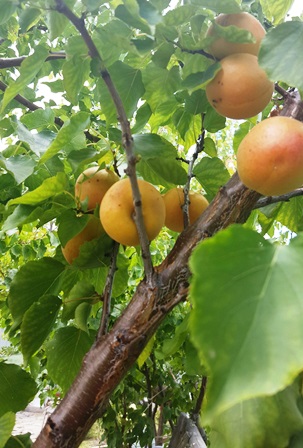
By mid-May, ripe apricots hanging on the trees in my backyard don’t last long–they’re eaten fresh, made into jams, and dried
Apricots in the Bay Area ripen in mid-May and peaches often ripen a bit later during the three months of summer (depending on the cultivar). If you love eating the fruit, don’t toss the pits. Consider that an apricot or peach grafted onto rootstock might cost upwards of $20 during bare-root season but $35 to $50 if sold in a pot. Growing from seed costs nothing.
Planting the seed extracted from the pit of your favorite apricot or peach variety can generate a tree with a very good chance of carrying the parent trees’ traits and producing fruit within three to five years. In fact, I’ve found that pits of my apricot, cherry, wild plum, peach, and nectarines that are left on the ground or discarded by the squirrels who’ve eaten the fruit will often sprout on their own.
Use this ten-step method to grow a peach or apricot tree from seed.
1. Choose a pit from a locally grown ripe fruit that tastes juicy and delicious.
2. Dry the seed on a paper towel in your kitchen window for several days.
3. Carefully crack open the hard shell of the pit to reveal the seed inside (it will resemble an almond).
4. Put the seed (or several seeds) in a sealed container in your refrigerator and let it chill for up to three months. The cool temperature exposure helps the seed get ready to sprout.
5. Time your removal of the seed from the refrigerator to a month before the last frost date in your area.
6. Cover the seed in water overnight and in the morning plant it a clear glass jar of potting soil (no lid on the jar).
7. Return the jar to the refrigerator and keep the seed moist until it has sprouted (about one month).
8. When the outside weather conditions are right (no more frost and the soil begins to warm), plant the seedling in your garden in fertile, well-drained soil.
9. Dig a basin around the planting hole for watering.
10. Mulch to keep down weeds and ensure the roots stay cool. In three years, watch for blossoms in the spring with fruit to follow.
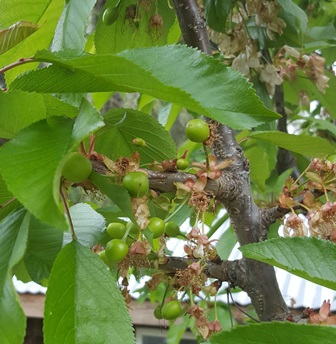
Cherry pits are much smaller than other stone fruit; pits of sour cherries (and also wild plums) may self-seed but sweet cherries less so. Cherries must have a period of cold to germinate
* * *
If you enjoy farmette topics like gardening heirloom vegetables, herbs, and fruits as well as keeping chickens and bees, check out my Henny Penny Farmette series of cozy mysteries from Kensington Publishing–A Beeline to Murder, The Murder of a Queen Bee, and A Hive of Homicides.
You’ll find in the Henny Penny Farmette series
-
Delicious recipes
-
Farm quips and quotes
-
Tips for gardening and keeping chickens and bees
-
An exciting whodunnit mystery
Also, check out MY POCKET MEDITATIONS, my newest forthcoming nonfiction title from Adams Media/Simon & Schuster, at http://tinyurl.com/l6lzorq
![My Pocket Meditations: Anytime Exercises for Peace, Clarity, and Focus by [Lester, Meera]](https://images-na.ssl-images-amazon.com/images/I/51GH%2BXEPc6L.jpg)
Stealing Away to Visit the County Fair
My daughter dropped by for a girl’s day out at the county fair. Summer chores are endless so taking a day off riddled me with guilt–and guilty pleasure.
We strolled under ancient, white bark sycamore trees that towered 50 to 100 feet above us. The first thing we saw as we entered the arched fair-grounds gate were goat pens. The cute little milking goats drew us over, but the odor of mounds of fresh horse manure turned us away. We kept on walking.
We moseyed over to see the sheep with their docked tails (apparently sheep like to chew on the tails of other sheep, so docking the tails eliminates pain and suffering and is more hygienic). We thought the baby goats were adorable. We marveled at how the pigs appeared so pink, healthy and robust. We couldn’t help but stare at the massive bellies and large bags of the dairy cows.
Embarking on the path to the exhibit halls, we relished how cool it was inside, a veritable respite from the heat. We strolled down aisles of quilts, art by high school students, and displays of jewelry. Then it was time to check out the jams. The entries of strawberry dominated the competition, but some included jam made with fig, plum, or rhubarb.
During the dessert competition, pies, brownies, and cakes beckoned us to peer into the glass display shelves. My daughter lamented that she wished they were for sale, reminding us it was time to eat.
We passed on the roasted corn on the cob and cotton candy, choosing simple tacos and Pennsylvania Dutch-style funnel cakes. I washed my meal down with the hibiscus-flavored drink sitting next to a dispenser of white horchata while my daughter stuck with water.
Before we left the exhibit halls and animals, I wanted to see the chickens. That competition must have happened on a different day, so I wandered over to the peacock pens next to the pigeons, finches, and parakeets. The peacocks were lovely but there were no peahens.
We checked out the bunny cages (I didn’t know there were so many kinds of rabbits) and decided against even looking at the reptiles (I tend to dream about them once I see them–and snake dreams aren’t usually pleasant).
All that walking and sensory stimuli wore me out. By the time we arrived home in the late afternoon, I needed a nap. I thought a day off was supposed to rejuvenate you. Instead, mine had done me in, but the trip to the fair gave me gobs of ideas for my cozy mystery series.
 Facebook
Facebook Goodreads
Goodreads LinkedIn
LinkedIn Meera Lester
Meera Lester Twitter
Twitter


